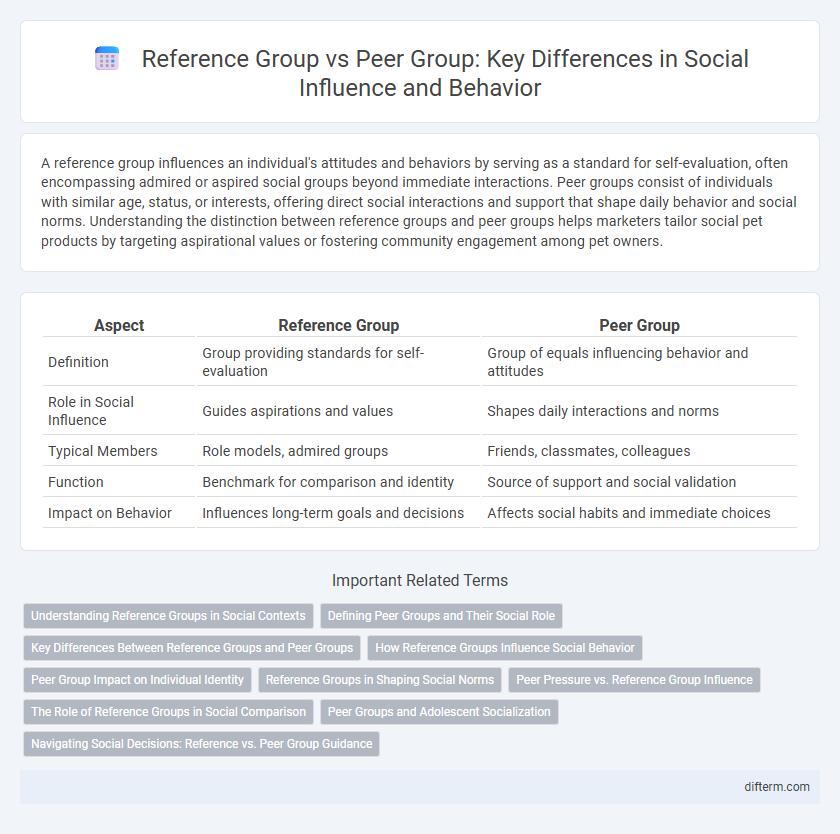A reference group influences an individual's attitudes and behaviors by serving as a standard for self-evaluation, often encompassing admired or aspired social groups beyond immediate interactions. Peer groups consist of individuals with similar age, status, or interests, offering direct social interactions and support that shape daily behavior and social norms. Understanding the distinction between reference groups and peer groups helps marketers tailor social pet products by targeting aspirational values or fostering community engagement among pet owners.
Table of Comparison
| Aspect | Reference Group | Peer Group |
|---|---|---|
| Definition | Group providing standards for self-evaluation | Group of equals influencing behavior and attitudes |
| Role in Social Influence | Guides aspirations and values | Shapes daily interactions and norms |
| Typical Members | Role models, admired groups | Friends, classmates, colleagues |
| Function | Benchmark for comparison and identity | Source of support and social validation |
| Impact on Behavior | Influences long-term goals and decisions | Affects social habits and immediate choices |
Understanding Reference Groups in Social Contexts
Reference groups influence individuals' attitudes, behaviors, and self-evaluations by serving as a standard for comparison, often encompassing groups to which people aspire or admire. Peer groups consist of individuals with similar age, status, or interests who provide direct social interaction and immediate feedback, shaping behaviors through everyday experiences. Understanding the distinction between these groups is crucial for analyzing social influence and identity formation in various contexts.
Defining Peer Groups and Their Social Role
Peer groups consist of individuals of similar age, interests, or social status who significantly influence each other's behavior, attitudes, and social development. They provide emotional support, shape identity formation, and serve as a primary context for socialization outside the family, reinforcing norms, values, and social skills. Unlike broader reference groups that serve as standards for self-evaluation, peer groups offer direct interaction and immediate feedback critical for social learning.
Key Differences Between Reference Groups and Peer Groups
Reference groups influence an individual's attitudes and behaviors by serving as a standard for self-evaluation, often including aspirational or non-members, whereas peer groups consist of individuals with similar age, status, or interests who interact directly and provide social support. Reference groups impact social norms and consumption patterns, while peer groups primarily affect socialization and daily interactions. The key difference lies in reference groups being more about comparison and influence beyond direct interaction, whereas peer groups involve active participation and reciprocal relationships.
How Reference Groups Influence Social Behavior
Reference groups significantly shape social behavior by providing standards and norms that individuals adopt to align with desired identities or statuses. These groups influence choices in fashion, speech, and values, often driving conformity even without direct interaction. Peer groups, as immediate social circles, reinforce these behaviors through direct social pressure and mutual feedback.
Peer Group Impact on Individual Identity
Peer groups play a crucial role in shaping individual identity by influencing behaviors, attitudes, and social norms during critical developmental stages. Interaction within peer groups fosters a sense of belonging and self-concept, often guiding choices related to lifestyle, language, and values. Unlike broader reference groups, peer groups provide immediate social feedback, reinforcing conformity or encouraging differentiation in personal identity formation.
Reference Groups in Shaping Social Norms
Reference groups exert a significant influence on shaping social norms by providing behavioral standards and expectations that individuals aspire to meet. These groups, often admired or esteemed, serve as benchmarks for attitudes, values, and decision-making processes, guiding conformity and social acceptance. Unlike peer groups, which consist of individuals of similar status or age, reference groups may include aspirational or broader societal segments, making their impact on social norms more pervasive and directive.
Peer Pressure vs. Reference Group Influence
Peer pressure exerts direct social influence from individuals of similar age or status, often driving behavior change through encouragement or coercion to conform within peer groups. Reference group influence shapes attitudes, values, and decision-making by providing social benchmarks and standards, impacting individuals even without direct interaction. The distinction lies in peer pressure's immediate interpersonal dynamics versus reference groups' broader normative guidance.
The Role of Reference Groups in Social Comparison
Reference groups serve as benchmarks for individuals to evaluate their own behaviors, attitudes, and social status, influencing self-perception and decision-making. Peer groups, while typically consisting of individuals with similar age or status, mainly provide direct interaction and support, whereas reference groups can be aspirational or symbolic, shaping ideals even without direct contact. The concept of social comparison is central to understanding how reference groups drive conformity, motivation, and identity formation within various social contexts.
Peer Groups and Adolescent Socialization
Peer groups play a crucial role in adolescent socialization by providing a social context where teenagers develop identities, norms, and values distinct from family influences. These groups influence behavior, attitudes, and social skills through shared experiences and direct interactions. Unlike broader reference groups, peer groups offer immediate feedback and support critical for emotional development during adolescence.
Navigating Social Decisions: Reference vs. Peer Group Guidance
Navigating social decisions often involves discerning the influence of reference groups, which provide standards and norms that shape attitudes and behaviors, compared to peer groups that offer direct interaction and immediate social feedback. Reference groups serve as aspirational or comparative models impacting long-term values, while peer groups influence everyday choices through shared experiences and social validation. Understanding the distinct roles of these groups enhances social decision-making by balancing external ideals with immediate social pressures.
reference group vs peer group Infographic

 difterm.com
difterm.com